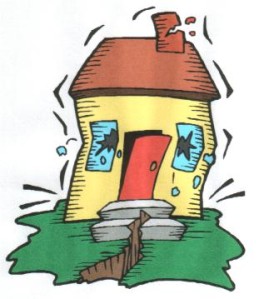Aristotle and the Flatulent Earth October 27, 2010
Author: Beach Combing | in : Ancient , trackback Beachcombing is always loath to give any publicity to the appalling Aristotle – and recently had a piece on Aristotle’s lost work on comedy wrung out of him against all his better judgement. However, after Beachcombing’s first experience of an earthquake last year he found himself grazing in Aristotle’s Metereology where the non-Platonic one gives the earliest surviving extensive western explanation for what causes the ground to shake.
Beachcombing is always loath to give any publicity to the appalling Aristotle – and recently had a piece on Aristotle’s lost work on comedy wrung out of him against all his better judgement. However, after Beachcombing’s first experience of an earthquake last year he found himself grazing in Aristotle’s Metereology where the non-Platonic one gives the earliest surviving extensive western explanation for what causes the ground to shake.
Beachcombing’s conclusion? Perhaps Aristotle was a better geologist than a philosopher, though that’s not saying much.
Aristotle begins by refuting previous theories by Anaxagoras of Clazomenae, Anaximenes of Miletus, and Democritus of Abdera who had attempted to explain earthquakes in terms of ether or rainwater. Aristotle is typically polite about his opponents – ‘this theory is perhaps too primitive to require refutation’ – and then moves on to his own solution – wind.
The earth is essentially dry, but rain fills it with moisture. Then the sun and its own fire warm it and give rise to a quantity of wind both outside and inside it. This wind sometimes flows outwards in a single body, sometimes inwards, and sometimes it is divided. All these are necessary laws. Next we must find out what body has the greatest force in movement. This will certainly be the body that naturally moves farthest and is most violent. Now that which has the most rapid motion is necessarily the most violent; for its swiftness gives its impact the greatest force. Again, the rarest body, that which can most readily pass through every other body, is that which naturally moves farthest. Wind satisfies these conditions in the highest degree (fire only becomes flame and moves rapidly when wind accompanies it): so that not water nor earth is the cause of earthquakes but wind, namely the inrush of the external evaporation into the earth.
Inevitable and, for Beachcombing, bizarre comparisons with the working of the human body follow. ‘We must suppose the action of the wind in the earth to be analogous to the tremors and throbbings caused in us by the force of the wind contained in our bodies. Thus some earthquakes are a sort of tremor, others a sort of throbbing. Again, we must think of an earthquake as something like the tremor that often runs through the body after passing water as the wind returns inwards from without in one volume.’
Beachcombing, to be fair, must note that Aristotle does base his theory on (flawed) observations and goes on to describe the bellowing of the earth and, perhaps most interestingly, ‘good earthquake weather’ – something that modern geologists would reject out of hand.
Aristotle unfortunately came back to haunt western civilisation when the schools of Paris opened their doors to the Stageirian in the twelfth century and when, later still, Thomas of Aquinas mistakenly became an Aristotelian. Indeed, Aristotle would be the main point of reference for medieval and renaissance scholars trying to explain what was happening under their unstable feet. Even after the catastrophic earthquake of Lisbon in 1755 Aristotle was the point of refutation for the many Iberian writers who waded in.
Personally, Beachcombing prefers Pliny claiming that earthquakes were underground thunderstorms – if one replaces air currents rubbing together with tectonic plates rubbing together isn’t there some truth in this? Or failing that Japan’s mythical catfish Namazu, who lives in the mud beneath the earth, and who would sometimes lash around causing the earth to tremble and houses to fall.
Still no accounting for taste.
Any other ancient, medieval or, indeed, modern earthquake explanations would be gratefully received. Beachcombing is salivating thinking of the strange theories that fringe geologists in the nineteenth century will have come up with. In short… open season on earthquakes! Drbeachcombing AT yahoo DOT com


